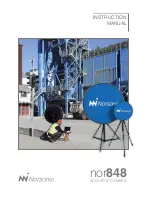
9
Norsonic Nor848
Instruction Manual
Setting the temperature
Ambient temperature affects the speed of sound. A cor-
rect value for the air temperature is therefore important in
order to calculate correct angles for the sound transmis-
sion. However, since this setting does not influence the re-
corded signal from the microphones, the adjustment may
be done after the recording has been made. The value
may be keyed in in the range -30°C to +40°C or dragged
by the handle. The calculated speed of sound is shown
below the handle for air temperature
Optical picture – Zooming and panning
The optical camera is a wide-screen camera with fixed
focus. The part of the picture to be displayed is selected
by the mouse or similar operation on the touch-pad. Grab
a position in the picture with the mouse pointer and move it
around - panning. Use the scroll wheel for zooming in and
out. On the touchpad use the pinch and pan functions for
zooming.
The pictures from the optical camera can be displayed in
colour or monochrome. A monochrome display is often
convenient when colours are used for displaying sound
levels. This selection is done by clicking the icon in the
upper right part of the main display.
It is also possible to freeze the picture and let it be stationary.
This allows you to take the picture at day time even if you
are going to make the noise analysis at night. The selection
is done by the photo/video camera icon in the upper right
corner of the picture display.
Zoom and increase beamforming resolution
The zooming and panning will also affect the acoustic
analysis. The colouration is based on listening in a num-
ber of certain directions. For frequency band colouration,
the number is an array of 15 x 11 directions (W x H), for
single frequency colouration, the number is 60 x 45. See
the description later for the difference between frequency
band and single frequency.
The example on the pictures to follow illustrate the effect
of zooming for frequency band colouration. We start by
Zooming out to show all sources.
The reflection from the ground is considered to be of less
interest and we want to zoom in on the two sources above
the ground. This is indicated by the frame in the picture
below.
By zooming in, a higher resolution is obtained for the
interesting part of the picture
The next picture shows
the display after the zooming operation. A grid is placed
on the picture to show the acoustic resolution for the level
colouring (Frequency band).
Display Settings
Adjusting the focal distance
In the same way as you need to focus on an object when
taking an ordinary picture, you need to specify a distance
from the microphone dish to the object under investiga-
tion. However, since this setting does not influence the re-
corded signal from the microphones, the adjustment can
be done after the recording has been made.
The focal distance is the distance between the micro-
phone dish and a plane parallel to the dish and through
the object under investigation. The selector for distance
and temperature is placed in the upper right side of the
display. The distance can be adjusted from 0,5 m to 100 m
(infinity) by the slider called “Array distance” in the upper
right corner of the display or entered manually.
Still picture/video selection
Black-white/colour selection
Содержание Nor848
Страница 1: ...INSTRUCTION MANUAL nor848 ACOUSTIC CAMERA ...
Страница 3: ...nor848 ACOUSTIC CAMERA ...
Страница 18: ...15 Norsonic Nor848 Instruction Manual ...



























